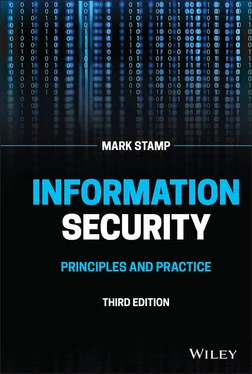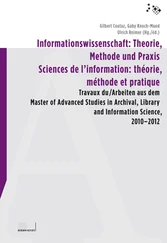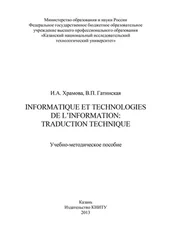Mark Stamp - Information Security
Здесь есть возможность читать онлайн «Mark Stamp - Information Security» — ознакомительный отрывок электронной книги совершенно бесплатно, а после прочтения отрывка купить полную версию. В некоторых случаях можно слушать аудио, скачать через торрент в формате fb2 и присутствует краткое содержание. Жанр: unrecognised, на английском языке. Описание произведения, (предисловие) а так же отзывы посетителей доступны на портале библиотеки ЛибКат.
- Название:Information Security
- Автор:
- Жанр:
- Год:неизвестен
- ISBN:нет данных
- Рейтинг книги:3 / 5. Голосов: 1
-
Избранное:Добавить в избранное
- Отзывы:
-
Ваша оценка:
- 60
- 1
- 2
- 3
- 4
- 5
Information Security: краткое содержание, описание и аннотация
Предлагаем к чтению аннотацию, описание, краткое содержание или предисловие (зависит от того, что написал сам автор книги «Information Security»). Если вы не нашли необходимую информацию о книге — напишите в комментариях, мы постараемся отыскать её.
Provides systematic guidance on meeting the information security challenges of the 21st century, featuring newly revised material throughout Information Security: Principles and Practice
Information Security
Information Security: Principles and Practice, Third Edition
Information Security — читать онлайн ознакомительный отрывок
Ниже представлен текст книги, разбитый по страницам. Система сохранения места последней прочитанной страницы, позволяет с удобством читать онлайн бесплатно книгу «Information Security», без необходимости каждый раз заново искать на чём Вы остановились. Поставьте закладку, и сможете в любой момент перейти на страницу, на которой закончили чтение.
Интервал:
Закладка:
1.2.2 Beyond CIA
Confidentiality, integrity, and availability are only the beginning of the information security story. Beginning at the beginning, consider the situation when AOB's customer Bob logs on to his computer. How does Bob's computer determine that “Bob” is really Bob and not Trudy? And when Bob logs into his account at Alice's Online Bank, how does AOB know that “Bob” is really Bob, and not Trudy? Although these two authentication problems appear to be similar on the surface, under the covers they are almost completely different.
Authentication on a standalone computer often requires that Bob's password be verified. To do so securely, some clever techniques from the field of cryptography are required. On the other hand, authentication over a network is open to many kinds of attacks that are not usually relevant on a standalone computer. Potentially, the messages sent over a network can be viewed by Trudy. To make matters worse, Trudy might be able to intercept messages, alter messages, and insert messages of her own making. If so, Trudy can simply replay Bob's old messages in an effort to, say, convince AOB that she is really Bob. As a result, authentication over a network requires careful attention to protocol, that is, the composition and ordering of the exchanged messages. Cryptography also plays a critical role in security protocols.
Once Bob has been authenticated by AOB, then Alice must enforce restrictions on Bob's actions. For example, Bob can't look at Charlie's account balance or install new accounting software on the AOB system. However, Sam, the AOB system administrator, can install new software. Enforcing such restrictions falls under the broad rubric of authorization. Note that authorization places restrictions on the actions of authenticated users. Since authentication and authorization both deal with issues of access to various computing and network resources, we'll lump them together under the clever title of access control.
All of the information security mechanisms discussed so far are implemented in software. And, if you think about it, other than the hardware, is there anything that is not software in a modern computing system? Today, software systems tend to be large, complex, and rife with bugs. A software bug is not just an annoyance, it is a potential security issue, since it may cause the system to misbehave. Of course, Trudy loves misbehavior.
What software flaws are security issues, and how are they exploited? How can AOB be sure that its software is behaving correctly? How can AOB's software developers reduce (or, ideally, eliminate) security flaws in their software? We'll examine these software development‐related questions (and much more) in this book.
Although bugs can (and do) give rise to security flaws, these problems are created unintentionally by well‐meaning developers. On the other hand, some software is written with the intent of doing evil. Examples of such malicious software, or malware, includes the all‐too‐familiar computer viruses and worms that plague the Internet today. How do these nasty beasts do what they do, and what can Alice's Online Bank do to limit their damage? What can Trudy do to increase the nastiness of such pests? We'll consider these and related questions.
Of course, Bob has many software concerns, too. For example, when Bob enters his password on his computer, how does he know that his password has not been captured and sent to Trudy? If Bob conducts a transaction at www.alicesonlinebank.com, how does he know that the transaction he sees on his screen is the same transaction that actually goes to the bank? That is, how can Bob be confident that his software (not to mention the network) is behaving as it should, instead of as Trudy would like it to behave? We'll consider these sorts of questions as well.
1.3 About This Book
Lampson [69] believes that real‐world security boils down to the following:
Specification/policy — What is the system supposed to do?
Implementation/mechanism — How does it do it?
Correctness/assurance — Does it really work?
Your humble author would humbly 3 add a fourth category:
Human nature — Can the system survive “clever” users?
The focus of this book is primarily on the implementation/mechanism front. Your self‐assured author assures you that this is appropriate, nay essential, for an introductory course, since the strengths, weaknesses, and inherent limitations of the mechanisms directly affect all other aspects of security. In other words, without a reasonable understanding of the mechanisms, it is not possible to have an informed discussion of other relevant security issues.
The material in this book is divided into four major parts. The first part deals with cryptography, while the next part covers access control. Part III shifts the focus to network security, where the emphasis is on security protocols. The final major part of the book deals with the vast and relatively ill‐defined topic of software. Hopefully, the previous discussion of AOB 4 has convinced you that these major themes are all relevant to real‐world information security.
In the remainder of this chapter, we'll give a quick preview of each of these four major themes. The chapter concludes with a summary, followed by several not‐to‐be‐missed homework problems.
1.3.1 Cryptography
Cryptography is a fundamental tool in information security. Cryptography has many uses, including providing confidentiality and integrity, among other vital information security functions. We'll discuss cryptography in detail, as a working knowledge of crypto basics is essential background for any informed discussion of information security.
We'll begin our coverage of cryptography with a look at a handful of classic cipher systems. In addition to their obvious historical and entertainment value, these classic ciphers illustrate the fundamental principles that are employed in modern digital cipher systems, but in a more user‐friendly format.
With this background, we'll be prepared to study modern cryptography. Symmetric key cryptography and public key cryptography are the two major branches of cryptography, and each plays a prominent role in information security. We'll spend an entire chapter on symmetric ciphers, and another chapter on public key systems. We then turn our attention to cryptographic hash functions, which are another fundamental security tool. Hash functions are used in many different contexts, some of which are surprising, or even bordering on the counterintuitive (e.g., blockchain).
Then we'll briefly consider a few special topics that are related to cryptography. For example, we'll discuss steganography, where the goal is, essentially, to hide information in plain sight.
1.3.2 Access Control
As mentioned above, access control deals with authentication and authorization. In the area of authentication, we'll consider many issues related to passwords. Passwords are the most oft‐used form of authentication today, but this is primarily because passwords are cheap, and definitely not because they are the most secure option. 5
We'll consider how to securely store passwords. Then we'll delve into the issues surrounding secure password selection and related issues. In real world systems, passwords often represent a major security vulnerability.
The alternatives to passwords include biometrics and various physical devices, such as smartcards. We'll consider some of the security benefits of these alternate forms of authentication. In particular, we'll discuss several biometric authentication techniques.
Recall that authorization deals with restrictions placed on authenticated users. The two classic methods for enforcing such restrictions are so‐called access control lists 6 and capabilities. We'll look at the plusses and minuses of each of these methods.
Читать дальшеИнтервал:
Закладка:
Похожие книги на «Information Security»
Представляем Вашему вниманию похожие книги на «Information Security» списком для выбора. Мы отобрали схожую по названию и смыслу литературу в надежде предоставить читателям больше вариантов отыскать новые, интересные, ещё непрочитанные произведения.
Обсуждение, отзывы о книге «Information Security» и просто собственные мнения читателей. Оставьте ваши комментарии, напишите, что Вы думаете о произведении, его смысле или главных героях. Укажите что конкретно понравилось, а что нет, и почему Вы так считаете.











